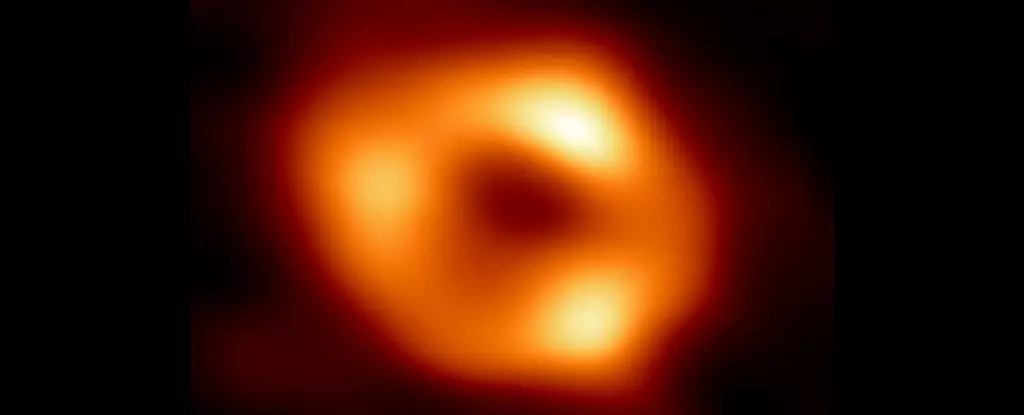The astronomical community was captivated by the groundbreaking image of Sagittarius A* (Sgr A*), the supermassive black hole nestled at the heart of our Milky Way galaxy. Released in 2022, this first-of-its-kind portrait showcased a bright ring surrounding a dark core, captured by the ambitious Event Horizon Telescope (EHT) collaboration. However, a recent study by researchers at the National Astronomical Observatory of Japan (NAOJ) casts doubt on the accuracy of that image, suggesting that Sgr A* may not be the perfectly circular object it initially appeared to be. Instead, their new analysis posits that the accretion disk around this celestial body possesses an elongated shape, inviting a fresh dialogue about one of the universe’s most enigmatic phenomena.
Central to the debate is the accretion disk, a swirling mass of hot gas and debris orbiting around a black hole. This disk plays a vital role in understanding the nature of black holes, as it reveals the dynamics of matter under extreme gravitational forces. The EHT team’s original analysis presented this disk as circular, a structure commonly expected due to the symmetrical nature of gravitational pull. Yet, the NAOJ researchers employed alternative analytical techniques to examine the same data, leading them toward a different conclusion. Their findings suggest the accretion disk is, in fact, elongated in the east-west direction, with the eastern side shining brighter than the western side. This revelation not only alters our visual conception of Sgr A* but raises pivotal questions about the physical processes governing black holes.
At the heart of the inconsistent imagery is the intricate nature of radio interferometry, the method used by EHT to capture the black hole’s visage. This complex technique unites signals from a global network of eight radio telescopes, forming a virtual Earth-sized telescope capable of producing high-resolution images of distant cosmic phenomena. However, as astronomer Miyoshi Mikato of the NAOJ indicated, such measurements are fraught with challenges. The data inherently contains gaps, which can lead to inaccuracies in image construction. The EHT team’s success in producing a ’round’ image came at the cost of some distortion, as they endeavored to fill these gaps using advanced algorithms.
In a bid for clarity, the NAOJ researchers approached the data differently. By applying new mapping methods and smoothing over the data gaps, they revealed an elongated disk. This alternative portrayal not only demonstrates how two interpretations can emerge from the same dataset but also highlights the intrinsic difficulties in cosmological imaging.
The differences between the two interpretations of Sgr A* extend beyond mere aesthetics. An elongated accretion disk suggests varying motions and distributions of matter within that disk. The brighter eastern section of the reanalyzed image may stem from Doppler boosting, resulting from the rapid rotation of material moving close to the speed of light. This acceleration contributes to a vibrancy in that region, signifying that the matter closest to the black hole is under extreme conditions.
Furthermore, the shape of the accretion disk is influenced not only by the speed of its rotation but also by additional factors like the spin of the black hole and the rate at which it absorbs surrounding material. These elements work in harmony, affecting the disk’s overall morphology and how we perceive it through our telescopes.
As the quest for understanding Sgr A* evolves, both the EHT consortium and NAOJ researchers are committed to refining their imaging techniques. The ongoing dialogue surrounding the black hole’s appearance underscores an essential truth in the scientific process: knowledge is not static. As technology advances, astronomers gain more sophisticated tools to explore celestial bodies in unprecedented detail. Improvements in imaging protocols and data-analysis methodologies will pave the road to clearer, more accurate representations of black holes and their surroundings.
Moreover, deepening our understanding of Sgr A* may have broader implications for the study of black holes throughout the universe. Observations of other supermassive black holes could yield insights into the fundamental processes that govern these enigmatic entities, enhancing our grasp of galaxy formation and the role these titans play in cosmic evolution.
In the realm of astronomy, certainty is often an elusive goal. The divergent assessments of Sagittarius A* remind us that our understanding of black holes is continually in flux. Both the EHT and NAOJ analyses offer valuable insights, and their ongoing discussions serve as a testament to the collaborative spirit that drives scientific discovery. As researchers work to untangle the threads of cosmic data, each revelation brings us one step closer to comprehending the profound mysteries of black holes and the universe itself.


Leave a Reply